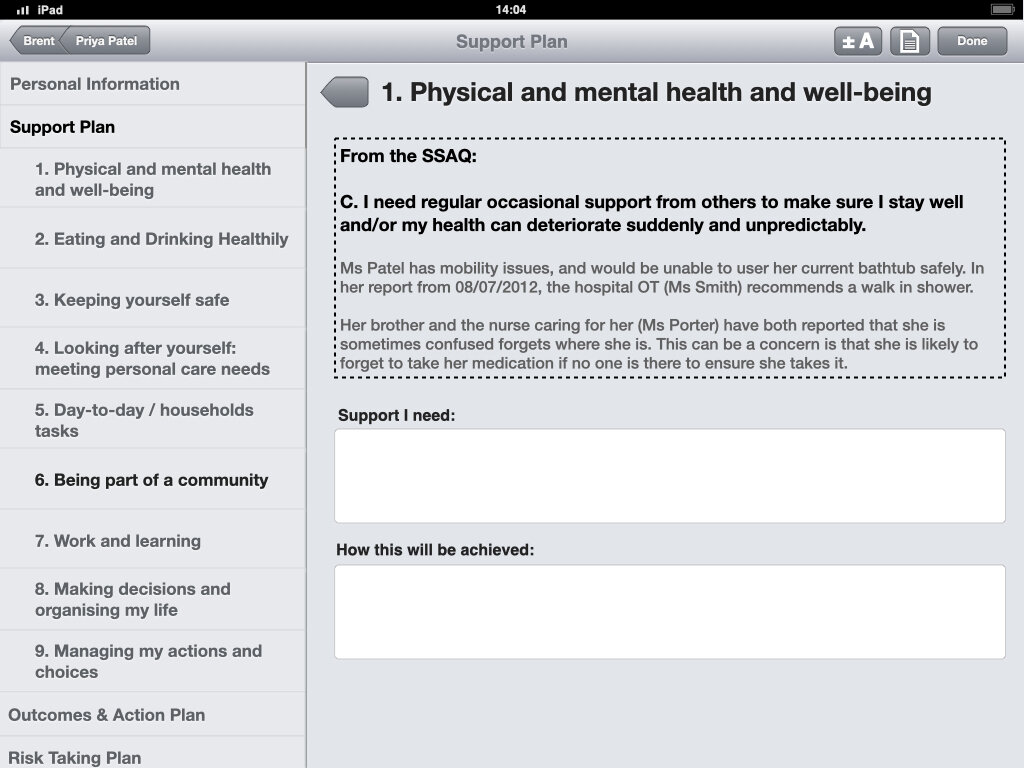Brent Council: App Concept for Social Care
User Research, Task analysis, Interaction Design
Brief
In a context of reducing council budgets and increasing care needs, my task was to assess whether the work of Brent social workers could be optimised by using a tablet application during their field visits. If the research shows potential, the next steps was to convince the Director of Adult Social Services to fund the project further.
Outcomes
The project was very well received by all the staff at Brent, from social workers (who appreciated how much it was shaped to fit their work) to the Director (who could see savings and potential to improve job satifaction). Some processes were changed immediately following this project, and funding was allocated to explore the application concept further.
Key challenge
The challenge was to identify and successfully communicate the complex potential for such an application to senior management in a short amount of time. This required a good understanding of the work social worker do, their environments, constraints, processes and aspirations.
Research highlights
“Our work isn’t about forms, but research and decisions.”
Dependence on working from the office wastes resources
- The current process required social workers to get back to the office to enter their notes from their client interviews into a desktop-only system.
- Travelling back and forth to the office was consuming about 40% of the time of social workers.
- These delays add up and often cause delays in council action, resulting in clients lacking support or having to stay in costly hospital beds longuer than they needed to.
- Social workers had to come up with their own ways to take notes on location, and then rewrite it all to fit the various forms.
- Often the same information had to be retyped or pasted accross several forms for a single case.
- Social workers really disliked spending time travelling and typing in forms, as they felt this was preventing them from spending more time with their clients.
No tool should come in between the social worker and their client
As creating a personal rapport with clients is key, social workers were concerned that a tool may interfere with their conversations. Forms to fill have specific questions and a specific order, which does not match the fundamentally fluid nature of personal conversations.
Staff would benefit for other digital assistance
A social worker's day is comprised of a lot of different appointments in many unfamiliar and varying locations such as people's homes, care homes and hospitals. Existing but underused digital tool such as a calendar and maps would help them manage their day.
The unnecessary long process to enter information, moving from digital to paper and back again.
The new digital and mobile process.
Design highlights: designing for a multi-step process
A key insight was that the form data entry needed to be split in two: quick data capture during the conversations, and precise data entry and upload afterwards.
During the conversations
To maintain the natural flow of the conversation, my design offered key functionalities:
- a quick navigation which allowed the social worker to skip to the topic at hand quickly regardless of its position in the paper form order
- a notepad section that is always a tap away allowing the worker to enter any information quickly without having to worry about where, or if, it fits in a specific form
- shorthand could be used.
After the conversations
After the visit, and at their own pace and in any location, the social worker could reopen the form, expand on their notes and make sure all information was entered correctly. This would also be the right time for submiting the data to the system, using the local wifi/mobile data connection that may not be functional where the clients are.
Between the conversations
There was also a need to help social workers manage their day with a calendar, travel directions and indoor hospital maps. While indoor maps could be included in our app concept as Pdf, recreating calendars and directions would needlessly duplicate built-in apps, so my prototype simply demontrated how these built-in apps could be integrated in the workflow.
Capturing data while still being able to navigate quickly to follow the natural conversation.
A freeform “scratch pad” is available with one tap from anywhere inside a patient’s form to capture information out of order.
After the visits, notes could be expanded upon, possibly using voice input for added speed.
What I did
- Convince my colleagues and the client that the project goal would be better served by spending time doing research with social workers on location rather than polishing a UI design.
- Shadowed and interviewed 25 social workers from 8 teams throughout their day, in the office and while they were conducting home and hospital visits.
- Analysed their needs and processes, finding potential improvements.
- Created a concept for a tablet application.
- Prepared a tappable prototype of the concept, illustrating a day in the life of a social worker once this project is completed.
- Used the prototype to present to senior management (including the Director of Adult Social Services) to demonstrate the concept, then summarised its benefits.
Preparing before a visit by copying data from the online system onto a paper pad
Captured action to take later when back in the office
Spending time entering in the system the information captured on paper while on site
Key contact information gathered over time, only available at the desk
The data wall I created to gather and analyse all my observations
A screen from the prototype, illustrating how all information and actions related to a client could be made easily available on location
Presenting the project during the conference “Public Sector Connect’s: New Ways Of Working” with Brent’s CIO Stephan Conaway (that’s me on the left)






